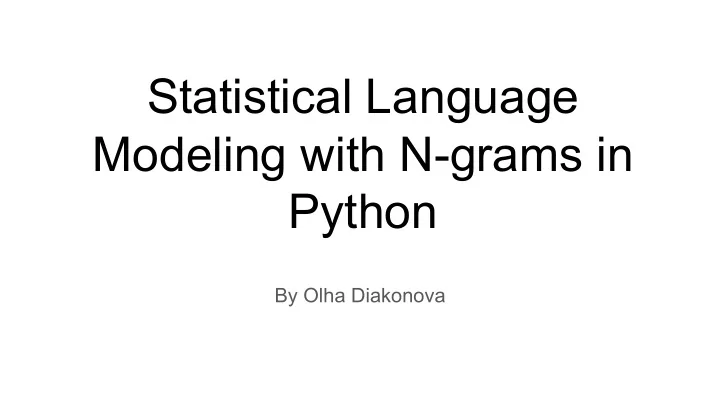

Statistical Language Modeling with N-grams in Python By Olha Diakonova
What are n-grams ● Sequences of n language units ● Probabilistic language models based on such sequences ● Collected from a text or speech corpus ● Units can be characters, sounds, syllables, words Probability of n th element based ● on preceding elements ● Probability of the whole sequence
Google N-gram Viewer
Probabilities for language modeling ● Two related tasks: P( that | water is so transparent ) = ● Probability of a word w given history h C( water is so transparent that) / P( w | h ) = P( w , h ) / P( h ) C( water is so transparent ) ● Probability of the whole sentence ● Chain rule of probability P(w n 1 ) = P(w 1 ) P(w 2 )|P(w 1 ) P(w 3 )|P(w 2 1 ) … P(w n |w n-1 1 ) = = ∏ k=1 P(w k |w k−1 1 ) ● Not very helpful: no way to compute the exact probability of all preceding words
Probabilities for language modeling ● Markov assumption : the intuition behind n-grams ● Probability of an element only depends on one or a couple of previous elements ● Approximate the history by just the last few words P(w n |w n−1 1 ) ≈ P(w n |w n−1 n−N+1 ) ● N-grams are an insufficient language model: The computer which I had just put in the machine room on the fifth floor crashed. ● But we can still get away with it in a lot of cases
What are n-grams used for ● Spell checking The office is about 15 minuets away. P(about 15 minutes away) > P(about 15 minuets away) ● Text autocomplete ● Speech recognition P(I saw a van) > P(eyes awe of an) ● Handwriting recognition ● Automatic language detection ● Machine translation P( high winds tonight) > P( large winds tonight) ● Text generation ● Text similarity detection
Implementing n-grams ● Unigrams: sequences of 1 sentence = 'This is an awesome sentence .' char_unigrams = [ch for ch in sentence] element word_unigrams = [w for w in sentence.split()] ● Elements are independent ● Concept is similar to print(char_unigrams) bag-of-words print(word_unigrams) ● Can be used for a dataset with sparse features or as a ['T', 'h', 'i', 's', ' ', 'i', 's', ' ', 'a', 'n', ' ', fallback option 'a', 'w', 'e', 's', 'o', 'm', 'e', ' ', 's', 'e', 'n', 't', 'e', 'n', 'c', 'e', '.'] ['This', 'is', 'an', 'awesome', 'sentence.' ]
Implementing n-grams from nltk import bigrams ● Bigrams: sequences of 2 elements sentence = 'This is an awesome sentence .' ● Trigrams: sequences of print(list(bigrams(sentence.split()))) 3 elements print(list(trigrams(sentence.split()))) Bigrams: [('This', 'is'), ('is', 'an'), ('an', 'awesome'), ('awesome', 'sentence'), ('sentence', '.')] Trigrams: [('This', 'is', 'an'), ('is', 'an', 'awesome'), ('an', 'awesome', 'sentence'), ('awesome', 'sentence', '.')]
Implementing n-grams sent = "This is an awesome sentence for making n-grams ." ● Generalized way of def make_ngrams(text, n): making n-grams for tokens = text.split() any n ngrams = [tuple(tokens[i:i+n]) for i in range(len(tokens)-n+1)] ● 4- and 5-grams: return ngrams produce a more for ngram in make_ngrams(sent, 5): connected text, but print(ngram) there is a danger of ('This', 'is', 'an', 'awesome', 'sentence') overfitting ('is', 'an', 'awesome', 'sentence', 'for') ('an', 'awesome', 'sentence', 'for', 'making') ('awesome', 'sentence', 'for', 'making', 'n-grams') ('sentence', 'for', 'making', 'n-grams', '.')
Implementing n-grams from nltk import ngrams ● NLTK implementation sent = "This is an awesome sentence ." grams = ngrams(sent.split(),5, pad_right=True, ● Paddings at string start & right_pad_symbol='</s>', end pad_left=True, left_pad_symbol='<s>',) ● Ensure each element of the sequence occurs at all for g in grams: print(g) positions ● Keep the probability ('<s>', '<s>', '<s>', '<s>', 'This') ('<s>', '<s>', '<s>', 'This', 'is') distribution correct ('<s>', '<s>', 'This', 'is', 'an') ('<s>', 'This', 'is', 'an', 'awesome') ('This', 'is', 'an', 'awesome', 'sentence') ('is', 'an', 'awesome', 'sentence', '.') ('an', 'awesome', 'sentence', '.', '</s>') ('awesome', 'sentence', '.', '</s>', '</s>') ('sentence', '.', '</s>', '</s>', '</s>') ('.', '</s>', '</s>', '</s>', '</s>')
Dealing with zeros ● What if we see things that never occur in the corpus? ● That’s where smoothing comes in ● Steal probability mass from the present n-grams and share it with the ones that never occur ● OOV - out of vocabulary words ● Add-one estimation aka Laplace smoothing ● Backoff and interpolation ● Good-Turing smoothing ● Kneser-Ney smoothing
Practice time ● Let’s generate text using an n-gram model! ● The Witcher aka Geralt of Rivia quotes
References 1. Dan Jurafsky. N-gram Language Models - Chapter from Speech and Language Processing: https://web.stanford.edu/~jurafsky/slp3/3.pdf 2. Dan Jurafsky lectures: https://youtu.be/hB2ShMlwTyc 3. GitHub: https://github.com/olga-black/ngrams-pykonik 4. Bartosz Ziołko, Dawid Skurzok. N-grams Model For Polish: http://www.dsp.agh.edu.pl/_media/pl:resources:ngram-docu.pdf 5. Corpus source: https://witcher.fandom.com/wiki/Geralt_of_Rivia/Quotes 6. Corpus source: https://www.magicalquote.com/character/geralt-of-rivia/
● Olha Diakonova ● Advertisement Analyst for Cognizant @ Google About me ● olha.v.diakonova@gmail.com ● GitHub: https://github.com/olga-black ● Pykonik Slack: Olha
Thank you very much!
Recommend
More recommend